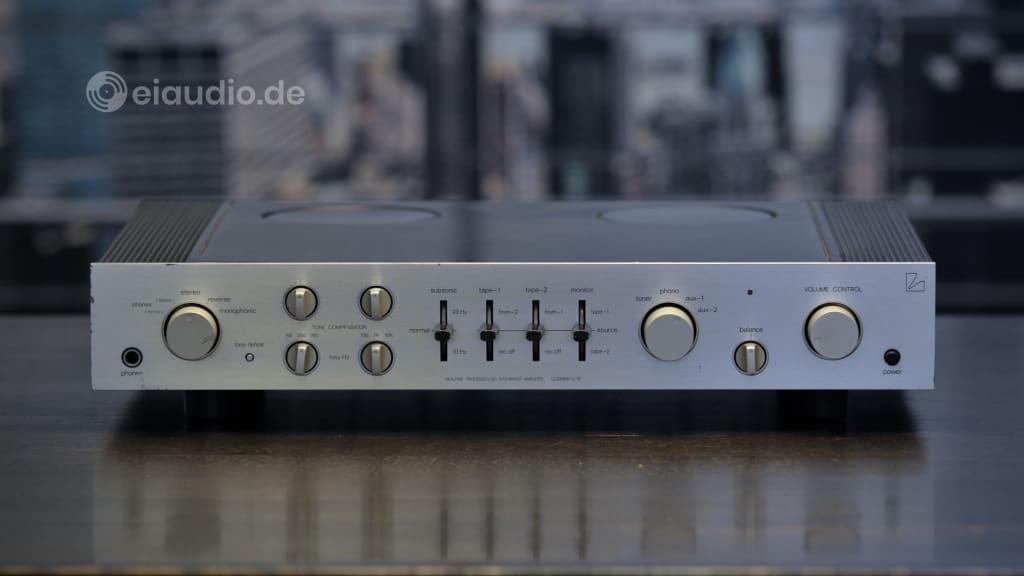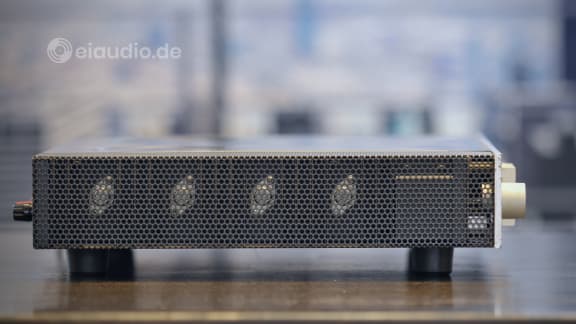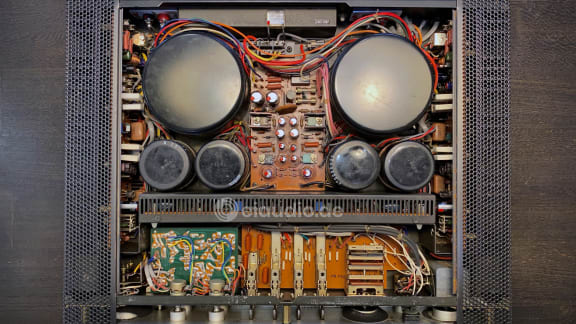Luxman L-10
Published: 06/04/2022
Manufacturing date: 1976
Author: Karsten Hein
Category: Gear & Review
Tag(s): Integrated Amplifiers
Just as I found myself suspended in audiophile bliss over our Becker ST-100 amplifier, Luigi dropped by our house on a casual visit carrying a small integrated amplifier under his arm and insisted that I give it a try at that very instant. I had long since understood that Luigi’s product demonstrations were nothing short of exceptional, and yet I was feeling more than just a little sad to dismantle my blissful setup of Restek V1 + Becker ST-100 separates to make room for a smallish-looking 55 watts integrated amp.
Being a great fan of separate pre and amplifier combinations to better match the sound of a system with the loudspeakers, it was only a small consolation to me that the integrated amplifier in question had been manufactured by Luxman in Japan, a company famous for creating some very exceptional designs back in the heyday of High-Fidelity. However, my impression changed considerably when I picked the Luxman up from the table where Luigi had placed it. At a weight of 10.5 kg, and featuring visible, shielded toroidal transformers for its two separate power supplies, the look and feel did seem more promising than I had first expected.
When positioned on a shelf, little about the Luxman L-10 demanded immediate attention. This was certainly not the type of amplifier that would start a conversation with a casual visitor to the house. However, for those interested in superb sound with knowledge of the industry, the L-10 would easily be accepted as the perfect understatement. 55 watts per channel might not seem like a lot of muscle judging from the figure alone, but when this was paired with a mindful internal layout, some exceptional components, and superb high current abilities, the result had the potential to be pure magic.
The L-10 is a member of the well-received Luxman ‘Laboratory Reference Series’ and steeped in the tradition of the 5C50/5M20 and C12/M12 amplifiers. It employed a clever DC amp configuration for both its pre and power amplification stages. The power amplifier was of dual-mono design and featured shielded toroidal transformers and large caps that facilitated high-current output and low-impedance drive capability. Its original Sanken 2SC1445/2SA765 output transistors were laboratory matched and of exceptionally high quality. Factors that made the L-10 both quiet and true to the music source. At the time of writing this, the special Sanken transistors were no longer in production, which had the potential of making replacements difficult. However, I did read that NOS offers could sometimes be found online.
The Luxman L-10 featured a newly designed volume control that kept channel imbalances to a minimum, and it had some attractive features to improve usability and connectivity. For example, the built-in preamplifier could be used separately in order to feed an external power amp, but also to serve as a headphone amp via the frontal headphone jack. All amp outputs offered the option of monaural down-mixing, a convenient feature when checking for channel imbalances or playing back monaural recordings. Another convenient feature was the stereophonic reverse playback switch that could invert the left and right channel inputs.
Instead of the usual +/- 6 dB tone controls that mostly had a degrading effect on sound quality by introducing phase shifts and signal loss, the L-10’s tone compensator allowed for +2 / -2.5 dB adjustments run through a passive circuit. The idea was for the owner to be able to mitigate tonal balance variations between different recording studios without sacrificing signal integrity. The variable control frequencies for bass were 50 Hz, 200 Hz, 700 Hz; and for treble 700 Hz, 3 kHz, 10 kHz. To protect the speakers from accidental harm, the amp output featured a protective circuit that would turn the amps off in the event of DC current output.
Listening to the L-10 play our favourite Jazz albums, I was surprised how seamlessly the integrated amplifier managed to pick up where the Restek V1 + Becker ST-100 separates had left off. In fact, the L-10 had nearly the exact qualities that had attracted me to the Becker ST-100 in the first place: It was tonally rich with a strong mid-bass presence and, at a mild damping factor of 80, it allowed the system to breathe. Layering of bass provided a tonally rich sound that made listening very enjoyable from the very start. While Luigi insisted that the Luxman had a tonally neutral approach to the music, our Tannoy speakers revealed a highly musical and juicy character.
Voices were depicted accurately and in an instantly pleasing manner, much like with the Becker amp. During vocal passages I would not have been able to tell the difference between the two, they were that close. Despite the slightly bloomy mid-bass, I was not able to detect a thickening of voices. Treble was focused, delicate, and elegant, just as one would expect from a well-protected signal path. Higher piano notes managed to free themselves from the speakers and take presence in the room. I was, indeed, very pleased with the performance I was being given by an integrated amplifier.
I must confess that under normal circumstances I would not have made any comparison between some of my favourite separates and the Luxman integrated amp. However, in this special case, having listened to the two so shortly after each other, I can say that the L-10 managed to hold its own very well. The differences were more or less a matter of personal taste. Luigi, for instance, gave preference to the Luxman’s slightly more controlled and agile sound, whereas I felt more drawn to the larger spacial representation, airiness, and punch of the separates.
The highest highs and the lowest lows were just a little more present on the beafier Becker ST-100 amp. There was also slightly greater physical separation between the instruments on the larger amp. On the other hand, the L-10 brought more speed and agility to the table that gave preference to faster music. For those looking for an integrated amplifier, the Luxman L-10 is most certainly worth considering. Refurbished models, such as the one presented here, are playing in a class of their own and can even compete with separate units at an audiophile level.
Specifications
- Type: dual-powered integrated stereo amplifier
- Features: Super-Class-A(/B), Realtime Processed
- Power consumption: 230 watts, max.
- Inputs: Phono MM, Tuner, Tape 1+2, AUX, Monitor
- Power output: > 55 WPC @ 8 Ohms; 75 WPC @ 4 Ohms
- Phono response: 20 Hz to 20 kHz (< 0.2 dB)
- Filters: Subsonic (10 Hz, normal, 20 Hz)
- Line response: 0 Hz to 100 kHz (< -1 dB)
- Total harmonic distortion: < 0.015%
- Damping factor: 80 (@ 8 Ohms, 1 kHz)
- Tone controls: bass, treble (+/- 2.5 dB, passive circuit)
- Variable control frequency: Bass (50 Hz, 200 Hz, 700 Hz); Treble (700 Hz, 3 kHz, 10 kHz)
- Phono input sensitivity: 3mV (MM), 300mV (line)
- Phono input impedance: 50k Ohms
- Signal to noise ratio: > 90 dB (phono), > 100 dB (line)
- Channel separation: > 85 dB
- Output: 300mV (line), 0.3V (Pre out)
- Dimensions: (W) 438 x (D) 363 x (H) 78mm
- Weight: 10.5 kg
- Country of manufacture: Japan
- Year(s): 1976-1982





